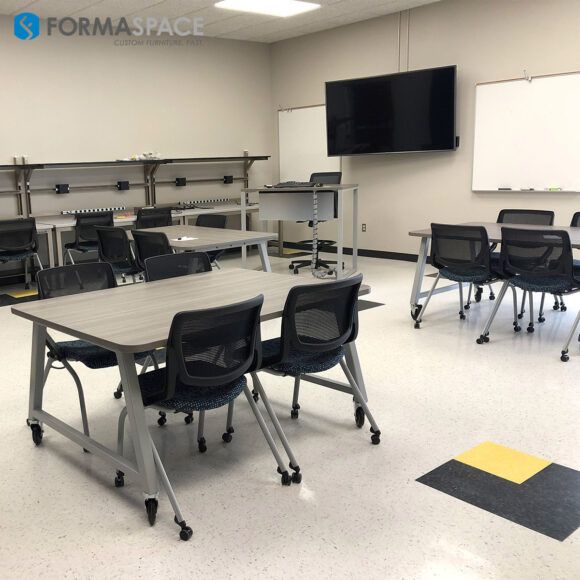The State of Education: Are We at Risk of Teacher Shortages This Fall?
As students graduate this spring, education administrators are breathing a sigh of relief.
But only for a moment.
The next concern on the horizon for many school district leaders is how to shore up the number of teachers they have on staff – to cope with the growing number of students expected to return to classrooms in the fall.
The Pandemic’s After Effects on the Teaching Profession
Uncertainty is the watchword for education hiring managers.
Student populations dipped precipitously during the height of the pandemic (as students dropped out due to Covid) but are inching upwards again.
Some districts are also projecting rapid growth of student populations due to a combination of inbound migration (not only between states but also between cities and suburbs) and demographic trends that project a higher number of kids entering their K-12 years.
A key challenge facing education hiring managers is that the teaching profession was front and center in the so-called Great Resignation, with many teachers leaving the profession for good. (We’ll examine some of the specifics reasons for doing so below.)
Compounding the problem is today’s low unemployment rate and highly competitive job market, which has led many companies to focus on poaching highly-qualified educators (particularly STEM instructors) to work in private industry or government positions outside the classroom.

Teacher (Dis)Satisfaction Surveys
Surveys of teaching professionals point to a variety of persistent concerns which make them call into question whether they can continue pursuing a career instructing students in a classroom setting.
A candid view of the current crisis from a teacher who recently quit the profession.
Here are some of the key reasons that teachers are electing to leave the profession:
· Fears for Personal Safety
The fear is real, particularly in light of yet another senseless classroom mass murder – this time at the Robb Elementary School in Uvalde, Texas (west of San Antonio), where (at the time of writing) two teachers and 19 students were killed by gunshot, making it worst school shooting since the 2012 Sandy Hook Elementary School mass shooting in Newtown, Connecticut. Firearms have become the leading cause of death for children and adolescents in the USA, surpassing motor vehicle accidents, according to a study published by The New England Journal of Medicine.
· Burnout, Stress, and Issues Surrounding Mental Health
The Covid pandemic and its aftermath have had a deleterious effect on teachers, significantly amplifying many of the concerns that existed pre-pandemic, including teacher burnout, intolerably high levels of stress, and concerns about mental health. In many cases, the root causes can be seen in the points that follow.
· Long Covid
The CDC now thinks that 1 in 5 people who contracted Covid could experience long-term symptoms of the disease, a condition dubbed Long-Covid. The presenting symptoms can range from heart and lung conditions to “brain fog” that interferes with cognitive functions, including memory. Some studies have concluded that teachers (along with other “essential workers”) have experienced higher rates of Covid infections than the rest of the population, and it also appears that a commensurately larger number of Long Covid diagnoses have affected the teaching profession as a whole, making it a significant cause of early teacher retirements.
· Long Hours and Uncompensated Work are Wearing on Teaching Staff
Generations ago, the K-12 teaching profession offered a unique tradeoff: teachers got summers off in exchange for less annual compensation. But taking 3 months off in the summer doesn’t reflect the reality for many of today’s teachers, who work full-time year-round. However, despite the restructured compensation packages, teacher employment surveys report strong dissatisfaction with current pay practices, which they say do not fully compensate them for the long hours of work performed outside of school hours, including carrying out administrative tasks, grading homework, tutoring students after-hours, etc.
· Rising Cost of Living, Especially Housing in Wealthy Areas
Inflation and the rising cost of living are hitting teachers especially hard.
Many teachers are taking on additional side work to keep up with their expenses.
Nationwide, housing prices have hit record levels, making the idea of purchasing a home increasingly out of reach for many teachers. The cost of the alternative, renting, is also causing distress, as rental rates have increased dramatically nationwide, driven in part by the trend of real estate investors buying up available rental properties and rising rents. The bottom line is that many teachers cannot afford to live in the school districts where they teach, particularly in gentrified city school districts or leafy suburbs – necessitating long commutes in many cases. But commuting has also become significantly more expensive recently due to the increase in both new and used car prices as well as the high cost of gasoline.
· Classroom Micromanagement, Teaching to the Test
Teachers also report significant dissatisfaction in light of what they consider unnecessary interference and oversight of classroom teaching plans, curriculum, and other mandates. For many teachers, there is also significant frustration with the need to “teach to the test” to raise test scores, upon which so much depends, including not only their school’s reputation, funding rates, and even independence (from state oversight), but also their own career goals, including potential promotions and compensation rates.
· Offensive Behavior by Students, Parents, School Boards, other Teachers, and Members of the Public
Teachers also report deteriorating levels of respect and civility in the classroom and on the school campus in general, as well as between teachers, administrators, and parents. For example, concerns over safety on campus have led some schools to institute a “one strike, you’re out” policy on items banned from the classroom, including knives or weapons or, in some cases, even active cell phones, but often enforcing these rules can put teachers in a no-win enforcement position of simultaneously being a teacher and a law enforcement officer. Personal attacks by parents at school board meetings that are directed at individual teachers or administrators not only add additional stress but also undermine confidence in the mission and raison d’être of being an educator in the first place.
· The Politicization of School Curriculum and Book Banning
Educators also feel their role is being undermined in other ways as well. Nationwide efforts to politicize school curricula are putting teachers and school administrators in the hot seat, and many are debating whether they want to continue with the profession during the current conditions. Also, many educators have strong feelings about banning books (another subject of an increasing number of political campaigns) and feel these efforts are destabilizing the ethos of education in America.

Are Teachers and School Administrators Quitting at an Unsustainable Rate?
Many school districts around the country report they are facing long-standing shortages in recruiting and retaining teachers.
The issue is not limited to teachers. A survey from NASSP signals that we may be on the cusp of a mass exodus of school principals as well, who, in some cases, are having to pitch in with janitorial duties due to a lack of available staff.
What does this mean for individual school districts?
Each teacher or administrator that retires or defects to a job outside the classroom pushes that district closer to a dangerous tipping point – one where they can no longer provide the educational services needed to support the number of students on their roster.
But even coming close to this point has unpalatable consequences.
As each experienced member of the teaching staff quits, they will inevitably be replaced by much less experienced teachers, which can lead to a vicious circle for the school district:
inexperienced teachers often result in measurably poorer educational outcomes, which can damage the reputation of the school, and lead to an exodus of students thanks to parents choosing to enroll their children in other school districts (where possible), in alternative/charter schools, or even in homeschooling programs.

What Recruiting Tools and Incentives Can Help Attract and Retain Teachers?
What can be done to stem the tide and help rebuild the education profession?
Here we can suggest some concrete steps school districts can take to improve the situation; though sadly, some of the changes necessary to restore the public comity of society at large (including reducing gun violence and returning to traditional values of civility and compromise) are beyond the scope of this article.
· Offer Higher Salaries and Bonuses
Are teachers underpaid?
If we look at the market value of educated professionals (such as teachers) in the open hiring market, the answer is probably yes. As we said at the outset, many choose the teaching profession as a labor of love, but given today’s economic challenges, love does not pay the rent.
Paying competitive salaries could help initiate a “virtuous circle” where the teaching profession attracts more talent, raising the level of effectiveness and proficiency across the board.
· Increase School Funding
Across much of the US, school capital projects are heavily reliant on issuing municipal bonds backed by local property taxes. A hodgepodge of federal, state, and local taxes (including proceeds from state lotteries in many cases) make up the balance.
Given the need to increase teacher salaries, It may be time to reexamine how school funding is structured and find more sustainable funding sources to pay for it.

· Build a Stronger Team of Quality Substitute Teachers and Support Personnel
Schools are increasingly facing the prospect of classroom cancellations when a teacher falls ill. Staffing levels are so tight there is simply not enough slack in the system to continue when an individual can’t come to work.
Efforts to recruit and retain teachers also need to focus on building the ecosystem of staff support around teachers, including quality substitute teachers and support personnel, including teaching assistants, tutoring specialists, and teachers in training.
· Improve Staff Wellbeing with Better Working Conditions
Working conditions – especially the attractiveness and well-being of the physical environment can play an incalculable role in helping support recruiting and retention programs in ANY industry, and the teaching profession is not excluded!
Classrooms with leaking roofs and windows, outdated restroom and cafeteria facilities, crowded hallways, and non-functional HVAC systems all convey a subconscious “nobody cares” message to teachers and students alike.
· Reimagining the Teaching Model
We recently wrote about “10 Ways Education Needs to Change Post-Covid,” which looked at some of the new technologies and evidence-based pedagogy that are helping change the teaching profession for good.
Teacher preparation programs, such as Arizona State University’s Mary Lou Fulton Teachers College, are also looking at re-tooling the approach schools take in educating tomorrow’s next generation of teachers.
Formaspace is Your Partner for Educational Facilities
If you can imagine it, we can build it, here at our Austin, Texas, factory headquarters.
Formaspace offers custom, American-made furniture solutions for your school classrooms, cafeterias, lounges, libraries, and laboratories.
Contact your Formaspace Design Consultant today to find out how we can work together to make your next education facility project a success.







